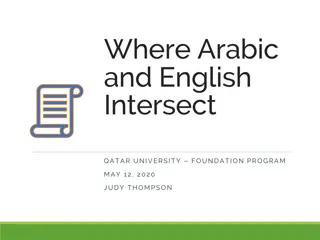Understanding Phonological Processes in English Language
Phonological processes involve changes in linguistic sounds over time, impacting language fluency and oral production significantly. EFL students can benefit from knowledge of these processes, like linking, gemination, elision, metathesis, assimilation, haplology, and coalescence, to enhance their language proficiency. Linking, for instance, connects words in speech, showing how consonants and vowels interact to create fluid speech patterns. By understanding these processes, learners can improve the quality and precision of their oral communication.
Download Presentation

Please find below an Image/Link to download the presentation.
The content on the website is provided AS IS for your information and personal use only. It may not be sold, licensed, or shared on other websites without obtaining consent from the author. Download presentation by click this link. If you encounter any issues during the download, it is possible that the publisher has removed the file from their server.
E N D
Presentation Transcript
PHONOLOGICAL PROCESSES
What do you think about the phonological processes? The linguistic sounds suffer a great quantity of changes, valuable both in the normal flow of the language and in the course of the time, and such changes are known as Phonological Processes. Pharies (2007)
Why do you think is important for the EFL students to know about the phonological processes? If we take into account that the oral production is considered as the process of producing, receiving and processing the information from a communicative and pragmatic point of view (Brown, 1994), we may comprehend the influence it has over the knowledge and effective employment of the Phonological Processes, since they allow the learners to increase their fluency while expressing their ideas, and consequently to improve the quality and precision of their oral production.
Types of phonological processes of the English language There are many phonological processes but we will study the most important one in the target language They are: Linking Gemination Elision Metathesis Assimilation Haplology Coalescence
Linking It is a process by which groups of words are connected together within the same phrase or sentence in connected speech. There are basically two types of linking: Consonant > vowel We link words ending with a consonant sound to words beginning with a vowel sound Vowel > vowel We link words ending with a vowel sound to words beginning with a vowel sound Let s see some examples
Linking Consonant to Vowel For example, in the phrase "turn off": We write it like this turn off We say it like this: tur noff Linking Vowel to Vowel If our lips are round at the end of the first word, we insert a W sound We write it like this: too often who is so I do all We say it like this: tooWoften whoWis soWI doWall If our lips are wide at the end of the first word, we insert a Y sound: We write it like this: Kay is I am the end she asked We say it like this: KayYis IYam theYend sheYasked
Elision Is the omission of one or more sounds (such as a vowel, a consonant, or a whole syllable) in a word or phrase, producing a result that is easier for the speaker to pronounce. Sometimes, sounds may be elided for euphonic effect. Let s see some examples
Examples: / k mf rt b l/ / k mf rt b l/ / f f / /h m/ / k mft rb l/ / k mft rb l/ / f / / m/ Comfortable: Fifth: Him: / l br t ri/ (American English), /l b r tri/ (British English) /l b r t ri/ Laboratory: / t mp r t r/ / t mp rt r/, / t mpr t r/ Temperature: / v d t b l/ / v d t b l/ Vegetable:
Assimilation It is a common phonological process by which the phonetics of a speech segment becomes more like that of another segment in a word (or at a word boundary). Let s see some examples
Examples: Family (fam-i-ly/fam-lee) Telephone (tel-e-phone/tel-phone) Separate (sep-are-rate/sep-rat) Chocolate (choc-o-late/choc-lat) Mathematics (math-e-mat-ics/math-mat-ics) Diamond (di-a-mond/di-mond) Betancourt y Galiffa (2009)
Coalescence It is a phonological process by which two neighboring sounds merge into a single sound that has properties of each of the two original sounds. Often, the resulting sound has the place of articulation of one of the source sounds and the manner of articulation of the other. Let s see some examples
Examples: [ [s s ] ] Sing / d u ke t/ Educate / r d u e t/ Graduate Measure / m r/
Haplology It is defined as the elimination of a syllable when two consecutive identical or similar syllables occur. Also, it is defined as the dropping of one of two similar or identical successive syllables or sounds in a word. Let s see some examples
Examples: ( (Amer. Amer. la br ri la br ri) > ) > la b ri la b ri Library Particuly Particularly Probly Probably Morphonemics Morphophonemics
Gemination In phonetics, gemination happens when a spoken consonant is pronounced for an audibly longer period of time than a short consonant. Gemination does occur across words when the last consonant in a given word and the first consonant in the following word are the same fricative, nasal or plosive. Let s see some examples
Examples: [ [k k m n m n] ] Calm man [ s d l] This saddle [bl k o t] Black coat [ b k k] Back kick [ r nd d u s] Orange juice























